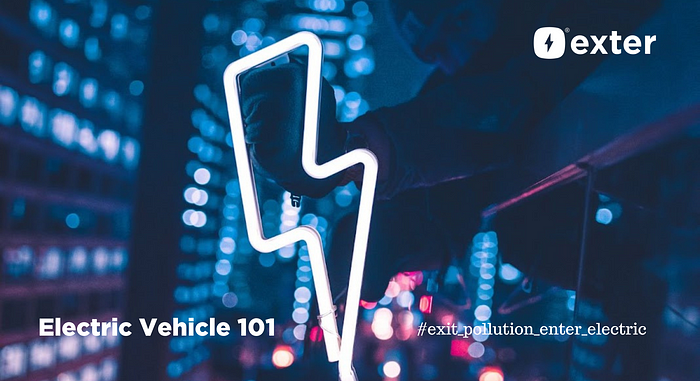What is an Electric Vehicle (EV) and types of EV

What is the need for an electric vehicle?
The world is switching to electric mobility. Before deciding to switch to electric mobility, it is good to know more about all aspects of this vehicle. Below mentioned are information and all the lingo associated with electric vehicles.
At exter, we believe in “exit pollution and enter electric i.e mobility with zero tailpipe emission”. Thus, we need to keep you updated with a few electric vehicle terminologies for making you familiar with them.
What is EV?
EV is the acronym for “Electric Vehicle”. The vehicle which runs or gets powered by electricity is called Electric Vehicle. They are either partially or fully powered by electric power. They are less or zero dependent on fossil fuels and have low maintenance costs.
Types of Electric Vehicles
Types of EV from exter2
There are multiple options available in the market for EVs. Here is a list of them
1. Battery electric vehicle/ fully electric
A vehicle is referred to as a battery-electric vehicle when its power source is solely electricity, as in the case of battery charging. The drive is completely dependent on the battery pack used. Swapping the battery/ charging the battery provides power to run longer.
2. Hybrid electric vehicle
HEV has both a fuel engine and an electric motor. The engine gets electricity from the battery and fuel to get the energy to run the vehicle. For a smooth ride, the drive is rotated and alternated between the fuel and electric motors.
3. Fuel cell electric vehicles
It is also referred to as zero-emissions automobiles. They obtain their energy from fuel cell technology, which transforms the chemical energy into the electricity needed to power the vehicle.
4. Plugin hybrid vehicle
They have both a fuel engine and an electric motor. You can choose whether you can use a fuel engine to run the vehicle or the battery pack for the electric motor to run the vehicle. The battery can be charged by connecting to an electric charging station that is readily available. Fuel engine runs on conventional petrol/ diesel fuel.
This would have given you a clear picture of the types of EVs available in the market. Now let us explain to you about the batteries available in the market for EVs.
The batteries
When internal combustion-engined cars/bikes get energy from fuel(petrol or diesel), an electric vehicle gets its power directly from a big pack of batteries.
There are majorly two popular types of batteries. Lead-acid and Lithium-ion batteries. The Li-Ion batteries used in EVs are similar to those used in smartphones, but they are scaled up and tightly packed.
Battery is the main source of power for an EV
Most electric and plug-in hybrid electric vehicles use lithium-ion batteries. Nickel-metal-hydride is commonly used in hybrid vehicles, and new materials such as lithium polymer and lithium iron phosphate are on the horizon to challenge those currently in use.
Parts of EV
- A fully electric car has fewer moving parts, about 20 moving parts in an electric engine, compared to nearly 2,000 in an ICEV.
- The most commonly found components are the Motor and Battery. The other parts are the controller/Throttle, brake pads, chassis, handlebar, electronics, wires, lights, mirrors, display screen, etc.
- The motor is the main component of an EV which determines the speed and torque of the electric vehicle. The throttle and the display screen control the performance. A charging port is also provided.
- The quality of the parts determines the range and price of any electric vehicle. It is entirely dependent on the brand that you choose to buy from.
EV basic information from exter2
Charging the battery
Now that you’re clear with the types and parts of an electric vehicle, let’s talk about the charging and usage of EVs.
When you purchase an electric vehicle, it includes a fixed battery that must be charged by plugging it into a charging station. Even if a charging station is available, it may be limited and the charging process may be slow. You need to wait until full charging. Even if the battery gets rapidly charged, it is at least an hour-long process. This not only reduces the performance but also burdens you with waiting time.
Swap with Exter
When you buy your EV with detachable batteries, you can use it conveniently, and when it’s time to charge you can swap it with another fully charged one and go on with your ride. Swappable batteries are a viable and efficient alternative for fixed battery issues. Addressing this, Exter is providing services across Bangalore and expanding the smart swapping stations for your betterment.
Swapping batteries brings not only quick rides but also reduces the hassle of electric scooter ownership. When you have the freedom to choose the right EV, make a wise decision of choosing it with detachable batteries and enjoy the advantage of having a battery with an unlimited warranty with the battery subscription.
Need for an Electric vehicle
The propagation of electric mobility keeps mother nature safe from the tailpipe pollution that every fuel vehicle causes. exter is proud to be a part of this healing process and assured to help you in healing and restoring Mother Nature. To know more about the advantages of electric vehicles, Click here.
To Conclude
Electric mobility is the new trend and for sustainable traveling, use swappable batteries. Switching to EV eliminates the need to be dependent on oil thus making it a good alternative for your mobility. The choice is yours. Make use of it and you will never regret it later.
Photo by Max Bender on Unsplash
Photo by Mika Baumeister on Unsplash
*This blog was previously written at exter.in/blog page. Content has been moved here to medium story.